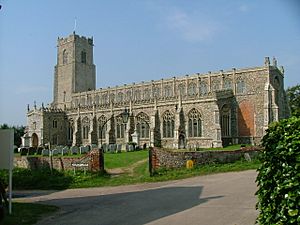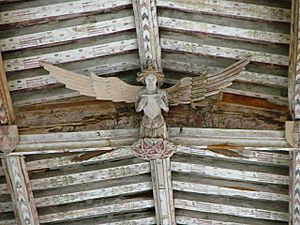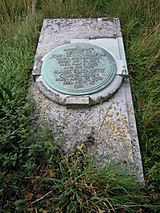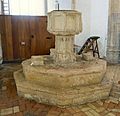Holy Trinity Church, Blythburgh facts for kids
Quick facts for kids Holy Trinity Church, Blythburgh |
|
|---|---|

Holy Trinity Church
|
|
| 52°19′16.21″N 1°35′41.14″E / 52.3211694°N 1.5947611°E | |
| Location | Blythburgh |
| Country | England |
| Denomination | Church of England |
| History | |
| Dedication | Holy Trinity |
| Architecture | |
| Heritage designation | Grade I listed |
| Specifications | |
| Length | 128 feet (39 m) |
| Height | 83 feet (25 m) |
| Administration | |
| Parish | Blythburgh |
| Deanery | Halesworth |
| Archdeaconry | Suffolk |
| Diocese | Diocese of St Edmundsbury and Ipswich |
| Province | Canterbury |
The Holy Trinity Church is a special church in the village of Blythburgh, located in the East Suffolk area of Suffolk, England. It is part of the Church of England and is a very important historic building. Since 1966, it has been given a "Grade I listed" status, which means it is a building of exceptional interest.
It's good to know that this church is different from the old ruins of Blythburgh Priory nearby.
Contents
A Look Back: The Church's History
This church is dedicated to the Holy Trinity and is often called the "Cathedral of the Marshes" because of its grand size in a marshy area. Blythburgh was one of the first places in East Anglia where Christianity was practiced.
Early Beginnings
There was a church here as early as 654 AD. It was a burial place for important people. King Anna and his son Jurmin were laid to rest here after they died in battle. They were descendants of King Wehha.
Around the time of the Norman Conquest, Blythburgh was a royal estate. Its church was one of the richest in Suffolk. It might have been a large Saxon church with two smaller churches connected to it. This important church was later given to a group of monks called Augustinian canons by King Henry I. This happened between 1116 and 1147, and it became the priory of the Blessed Virgin Mary.
The Holy Trinity Church we see today was likely one of those smaller churches. It was rebuilt in the 1400s. Later, in the 1500s, many monasteries were closed down. Blythburgh Priory was closed in 1537. Its property was then given to a local gentleman named Sir Arthur Hopton in 1548.
Challenges and Changes Over Time
The church has faced many challenges, both from nature and from people.
The Great Storm of 1577
One of the most dramatic events happened on August 4, 1577. A huge storm hit the area during a church service. Lightning struck the church, damaging the door and the steeple. The falling spire also harmed the font and the roof. The roof wasn't fully fixed until 1782.
The door still shows marks that look like burns. These marks are linked to a local legend about a ghostly black dog called "Black Shuck". This legend even inspired a song by the band The Darkness, which mentions Blythburgh.
Changes During the 1600s
In the 1600s, the church was damaged again. During this time, a group called the Puritans wanted to remove anything they thought was "superstitious" from churches. A local Puritan named William Dowsing visited Holy Trinity Church on April 8, 1644. He ordered the removal of many religious images and symbols, including crosses and angels.
Neglect and Restoration
Over time, the church also suffered from neglect. This was partly due to poverty in the countryside. Also, new religious groups like Methodism became popular. A Methodist chapel was even started in Blythburgh in the 1830s.
By the late 1800s, the church was in very poor condition. In 1881, money was raised to repair it. The church reopened in 1884. However, the restoration was not easy. Some people, like William Morris, were against the big changes planned by the local committee. There wasn't enough money to do everything.
The church's original 1400s ceiling had brightly painted angels in red and green, with shiny tin foil and gold leaf. During the restoration, modern tastes meant these colors were not brought back. Today, a new copy of an angel is placed above the south door.
The Church Today
The church has a two-manual pipe organ made by Bishop and Son in 1951. It was almost completely rebuilt in 2003.
In 1962, the famous composer Benjamin Britten discovered how good the church's acoustics were for music. Since then, some concerts for the Aldeburgh Festival have been held there.
The church was also used in 2011 for a music video for the song Sempiterna by the choir Libera.
In the churchyard, there is a grave for a British sailor from the Second World War. His name was Reginald George Arthur Remblance, and he died in 1944 at age 31.
Parish Status: Who It Serves
The Holy Trinity Church in Blythburgh is part of a group of churches called the Sole Bay Team Ministry. This group includes:
- St Margaret of Antioch's Church, Reydon
- St Andrew's Church, Sotherton
- St Lawrence Church, South Cove
- St Edmund's Church, Southwold
- St Mary's Church, Uggeshall
- St Andrew's Church, Walberswick
- St Peter and St Paul's Church, Wangford
Jack o' the Clock: A Unique Feature
The church is known for its "jack o' the clock", which dates back to 1682. In 1840, this figure stood in the tower and chimed the hours. Below it was a message: "As the hours pass away, So doth the life of man decay."
Today, the Jack stands on a shelf near the organ. It is still rung to announce the start of church services.
Notable Burials
The grave of the Victorian artist John Seymour Lucas RA (1849-1923) is in the churchyard.
Images for kids













